Physical Tour
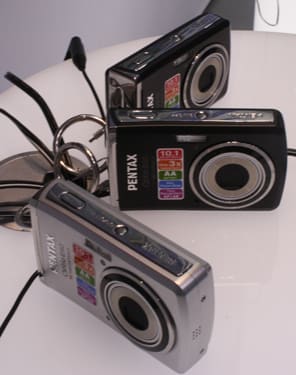
Front
The front of the E60 has a straightforward design. The lens takes up the right half of the body, with a silver ring around the base. Eleven o'clock from the lens is the flash and auto focus assist lamp. Written across the left of the camera's front are the manufacturer, model name and number of megapixels. The right edge of the body has a distinctive convex curve.
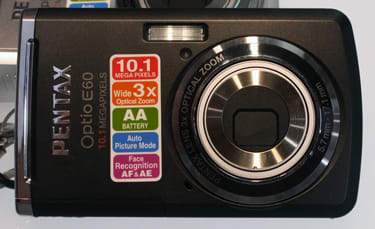
The lens is the dominant feature of the front
Back
Two thirds of the rear of the camera is taken up by the LCD screen, which measures 2.4' diagonally, with 112,000-pixel resolution. This is far lower than most other point-and-shoots on the market, the vast majority of which are at least 230,000 pixels. The remainder of the rear is devoted to the control system and a small LED indicating that the camera is on. The latter is very close to the upper right corner of the LCD screen, and to its right are the zoom controls. Beneath these are two buttons and the raised bumps of the thumb rest. The two buttons are Play on the left and Face Detection on the right. The former switches the camera into playback mode, the latter toggles face detection, which can detect up to 10 individuals at a time. The four-way pad is used to control most menu browsing, and handles double duty in shooting mode, where Up changes drive mode; Left alters flash; Down displays the capture mode palette (scene modes) and Right adjusts the focus mode. Once again, the left side of the E60's projects outward in a gentle curve.
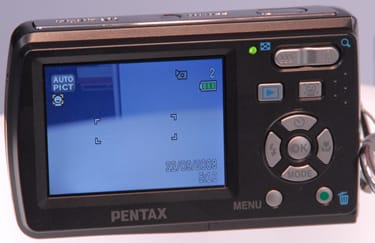
The LCD is small and unimpressive, but the buttons are large and clear
Sides*
*The slightly projecting left side is almost entirely bare except for the speaker approximately half way up the body. The chromed right side is of slightly more interest, with the strap lug midway down, and the DC power coupler cable cover right near the bottom. The coupler is an optional DC input shaped like two AA batteries that can slide into the battery slot, with the power cord snaking out the small cover.
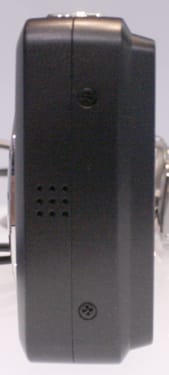
The left side is mostly bare**
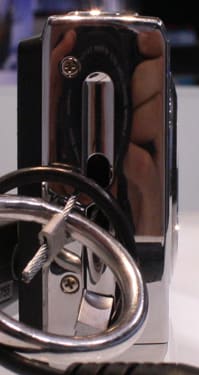
*The right side of the E60 is chromed
*
The top of the camera features a distinctive chromed plastic strip that acts as highly reflective visual accent. Unfortunately, it also acts as a magnet for smudges, especially seeing as your fingers will be resting there almost constantly. The power button is placed centrally along the top of the camera, and the shutter control button is on the far right, both of which are chrome too. The far right of the camera isn't square, but rather curves inward towards the front, and has a small chrome projection.

The chrome stripe on the roof of the E60 attracts thumb prints
The bottom of the E60 is mostly nondescript, but has one or two features of note. The USB port is placed underneath the camera slightly recessed from the left end, a very unusual and relatively inconvenient spot, with no protective cover to keep dirt and grime out of the connector.The tripod mount is lens centered, and the right half of the E60's bottom is taken up by the battery and memory card cover. The cover is a standard spring-loaded affair, and feels fragile, like much of the rest of the camera. Beneath this cover are the ports for SD/SDHC cards for memory, and the battery slot. The E60 takes two AA batteries, which is convenient for powering up without carrying around a charger while traveling.

The bottom is minimal
Components
LCD Screen
The LCD screen WAS hit hard by the cost cutting measures that brought the E60 in at such a low price. A small, low-resolution LCD was used, only 2.4' diagonal, and 112,000 pixels. This is, quite frankly, sub-par, and lower than almost any other camera on the market.
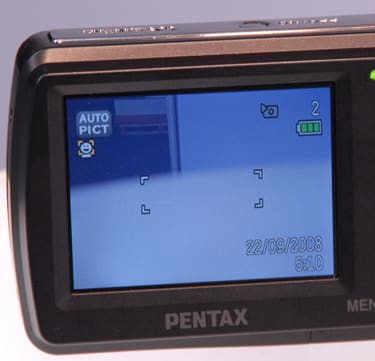
The LCD screen is small and low-resolution**
**
Flash
The flash is small, close to the lens, and not very powerful. The nearness to the lens has potential to cause frequent problems with red-eye. The flash options available are flash auto, off, on, red-eye auto, red eye on.
**

The flash is small and anemic.
******Lens**
The lens E60 has 3x optical zoom, and offers an aperture range of f/2.9 to f/5.2 with a focal range of 5.7mm to 17.1mm. This is a fairly standard spec for an inexpensive camera.
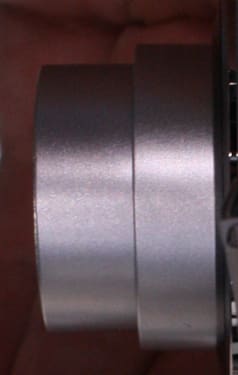
The lens is competent, if unexciting
Connections
The E60's only output is a micro-USB port that can connect to either a printer, computer or a television for video output. The port is not protected in any manner, and so there's a good chance something will foul the connection.
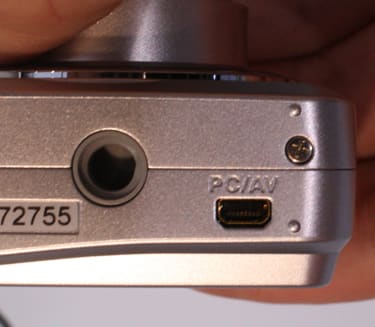
An uncovered port is just asking for trouble
Battery
The Pentax E60 accepts AA batteries as a power source. Cheap and ubiquitous in even the most far-flung corner of the earth, this feature makes the camera ideal for travel. There is also an optional DC adapter, shaped like two AAs, which allows you to plug the camera directly into the wall. When using standard AA alkaline batteries, the E60 is rated for 200 images.
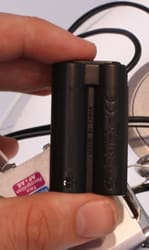
The optional DC adapter**Memory**
The E60 takes both SD and SDHC cards, which allows up to 32GB of storage.
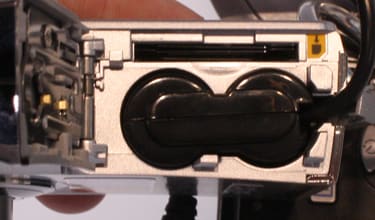
The memory card slot is very near the battery
Design / Layout
******Model Design / Appearance
**The E60's design is very simple, with large buttons, clear labeling and no unnecessary flourishes. The problems we had with the design is the inclusion of chromed areas, which easily become smeared with fingerprints, and the fact that the camera feels cheap and shoddily constructed.
Size and Handling
It was hard for us to fully judge the handling of the unit, as it was tethered by a very strong retractable cord during our hands-on session. What we did notice, however, is that E60 is light to the point of ludicrousness. It almost feels like a toy in the hands of an adult. It is quite small, 3.9' wide x 2.3' high x 0.98' (9.9 x 5.8 x 2.5cm) deep, and weighs only 6.2oz (176g). This lightness and size do make it small enough to easily toss into a backpack or tuck in a pocket.
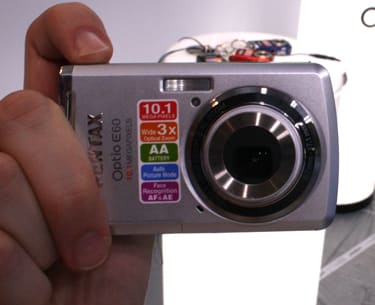
*
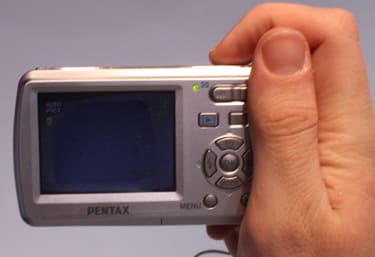
- Lightness can either be a blessing or a curse, depending on your preference.
Menu
Pentax's menu systems tend to be quite well organized and laid out. The menus are divided into shooting and settings, with two pages of each. Since there are so few options available to alter, working through the pages takes next to no time. There's also a nice little feature called Memory, where you can set which options will reset when the camera is turned off.
Ease of Use
The E60 is extraordinarily simple to use. Rather than offering an Auto mode with some flexibility, Pentax insists on using 'Green Mode' activated by the green button. This mode completely removes any settings control from the user's grasp, though it does but makes it an utter breeze for those who don't want to learn the ins and outs of their cameras.
Modes
Auto Mode**
The E60's automatic mode, called Green Mode, is all-encompassing, and strips the user of any control. Even Program Mode, which is meant to allow at least a modicum of user choice, only lets you alter basic settings such as focal area, white balance and ISO.
Movie Mode
Movie mode offers two size choices (640 x 480 or 320 x 240), and two frame rates (30 or 15 fps), with electronic shake reduction optional.
Drive / Burst Mode
**The E60 has two levels of burst-mode shooting. First there's continuous, which takes photos as fast as it is able for as long as the shutter button is depressed, or until the memory card runs out of space. In our brief hands-on with the camera, this appeared to be approximately one shot every 1.8 seconds, not exactly speed-demon performance. There's also a mode called 16 frame shooting, which will take 16 shots over two seconds, but at the small fixed size of 640 x 480.
Playback Mode
Playback mode has the usual bevy of editing and playback tools available (crop, rotate, resize, transfer, red-eye compensation, protect transfer and DPOF). You can also tint the image to one of seven colors or turn it black-and-white using the digital filter tool. Brightness filter lets you tweak the brightness level of the image and frame composite lets you overlay one of 27 framing graphic images over your photo. Finally, there's a feature called Recover that can recall accidentally deleted images.
Custom Image Presets**
The E60 has 17 different image presets, most of which are tried-and-true standards. There's program, night scene, night scene portrait, half-length portrait (automatically digitally zooms to the appropriate area, with a preset size of 3M), movie, landscape, flower, portrait, surf and snow, sport, digital SR (digital image stabilization), kids, pets (which lets you choose the color and type of your pet as long as you have a cat or dog), food, digital panorama, frame composite (with 27 frames) and voice recording.
Control Options
Manual Control Options
The E60 has no manual controls to speak of. The most flexible setting is Program mode, and even here manual input is minimal. There is no way to directly set the aperture or shutter speed.
Focus
Auto Focus
The auto focus appeared to work relatively well, and quite quickly. Face detection is available in every mode, and can handle up to 10 faces. Focus modes available are Multiple, Spot and Automatic Tracking.
ISO
The E60 has an ISO range of 100-6400, which sounds generous, except ISO 3200 and 6400 are only available at a reduced 5M resolution.
White Balance
The E60 has no manual white balance controls, which is disappointing, and symptomatic of the overall lack of control options on the camera.
Metering
The E60 has no metering controls, which is no great surprise given the overall design direction.
Shutter Speed**
The shutter speed of the E60 ranges from 1/2000 to 1/4 second, or as long as 4 seconds in Night Mode. We would ordinarily hope to see more exposure lengths beyond 1 second.
Aperture
The aperture range of the Pentax lens on the E60 is f/2.9 at the widest end, and f/5.2 at maximum telephoto.
**Image Stabilization
**Called Shake Reduction, the E60 has a digital image stabilizer that is only accessibly as a scene mode/image preset. We did not get a chance to test it, so we cannot vouch for its effectiveness.
Picture Quality / Size Options
Images can be taken at a range of sizes from 640 x 480 to 3648 x 2736 (10.1 megapixels), with a 16:9 widescreen 1920 x 1080 option as well.
**Picture Effects Mode
**The E60 will let you stick one of 27 different composite frames over your picture, so your amour can be surrounded by border of hearts, if you so choose. You can also cast various hues over the image using Digital Filters while editing during playback.
Conclusion
**
Conclusion**
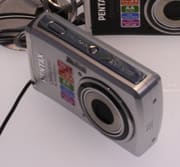
This camera is one of the most affordable on the market, and it shows in the overall feeling of tackiness, lack of control and sub-optimal manufacturing. However, due to this low price, its minuscule weight, and the ability to use AA batteries, this might be considered a good camera for traveling, as an almost-disposable model. It won't set you back much, doesn't take up a huge amount of space in your bag, and if it falls off the top of Machu Picchu, you won't be that upset. Just watch out for that exposed USB port underneath. Alternatively, it could make a good children's camera due to its low price point and simple interface. It's $60 cheaper than the Canon E1, which is being aimed at a younger market, and the E60 has the advantage of being gender neutral, while the E60 is colored in clichéd girl-market hues.**
**
Specs / Ratings
**Specs Table
**{{manufacturer_specs_table}}{{raw_scores_table}}
Meet the tester
Tim Barribeau is a valued contributor to the Reviewed.com family of sites.
Checking our work.
Our team is here for one purpose: to help you buy the best stuff and love what you own. Our writers, editors, and lab technicians obsess over the products we cover to make sure you're confident and satisfied. Have a different opinion about something we recommend? Email us and we'll compare notes.
Shoot us an email